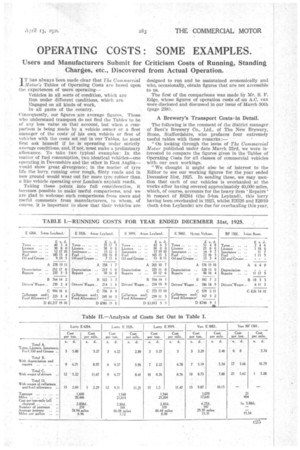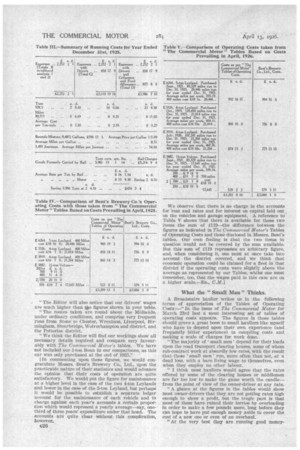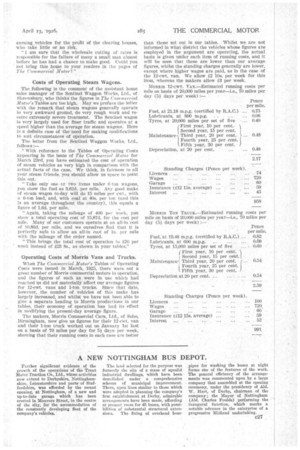OPERATING COSTS; SOME EXAMPLES.
Page 9

Page 10

Page 11

If you've noticed an error in this article please click here to report it so we can fix it.
Users and Manufacturers Submit for Criticism Costs of Running, Standing Charges, etc., Discovered from Actual Operation.
TT has always been made clear that The Commercial -I-Motor's Tables of Operating Costs are based upon the experiences of users operating
Vehicles in all serfs of condition, which are Run under different conditions, which are Engaged on all kinds of work, In all pants of the country.
Consequently, our figures are average fgrires. Those who understand transport do not find the Tables to be of any less value on that account, but when a comparison is being made by a vehicle, owner or a fleet manager of the COSta of his own vehicle or fleet of vehicles with the costs set out in our Tables, he 'Mist first ask himself if he is operating -under strictly averagoconditiens, and, if not, must make a preliminary allowance. To take: two typical examples : • In the matter of fuel consumption, two identical vehicles-one operating in Devonshire and the other in East Angliawould show great stlivergende; in the matter of tyre life the lorry, running over rough, flinty roads and in new ground would wear out far more tyre rubber than a like vehicle' operating over London's asphalt roads. Taking these points into full . consideration, 1.t becomes possible to make useful comparisons, and we are glad to welcome such comparisons from users and useful comments from manufacturers, to whom, of course, it is important to show that their vehicles are
designed to run and be maintained economically and who, occasionally, obtain figures that are not accessible to us.
The first of the comparisons was made IV Mr. S. F. Edge, whose figures of operation costs of an A.C. van were discloged and discussed in our issue of March 30th (page 238).
A Brewery's Transport Costsoin Detail.
The following is the comment of the district manager of Bent's Brewery. Co., Ltd., of The New Brewery, Stone, Staffordshire, who prefaces four extremely
useful tables with these remarks:• " On looking through the issue of The CommerciaZ Motor published under date March 23rd, we were interested to compare the figures given in the Tables of Operating Costs for all classes of commercial vehicles . with. our own workings.
"We thought It might also be of interest to the Editor to see our working figures for the year ended December 31st, 1025. In sending these, we may mention that each of our vehicles is overhauled at the works after having covered approximately 40,000 miles, which, of course, accounts for the heavy item Repairs' in respect of E0204 (the 5-ton Leyland), this lorry• having been overhauled in 1925, whilst E3320 and E3919 (both 4-ton Leylands) are due for overhauling this year.
"The Editor will also notice that our drivers' wages are much higher than *e figures shown in your table.
" The routes taken are round abotit the Midlands, under ordinary conditions; and comprise very frequent runs from Stone to Chester, Wrexham, Liverpool, Birmingham, Stourbridge, Wolverhampton and district, and the Potteries district.
"We think the Editor will find our workings show all necessary details required and compare very favourably with The Commercial Motor's tables. We have not included our 1-ton Bean in our comparisons, as this car was only purchased at the end of 1925."
Din commenting upon these figures, we would congratulate Messrs. Bent's Brewery Co., Ltd., upon the practicable nature of their statistics and would advance the opinion that their costs of operation are quite satisfactory. We would put the figure for maintenance at a higher level in the case of the two 4-ton Leylands and lower in _the case of the 5-4011 Leyland, but perhaps it would be. possible to establish a separate ledger account for the maintenance of each vehicle and to charge against each year's accounts a certain proportion which would represent a yearly average-say, onethird of three years' expenditure under that head. The accounts are quite clear without this complication, however, 026 We observe that there is no charge in the accounts for 'rent and rates and for interest on capital laid out on the vehicles and garage equipment. A reference to Table V shows that there is available for these two items the sum of £119-the difference between the figures as indicated in The Commercial Motor's Tables of Operating Costs and those disclosed in Messrs. Bent's tables. Our own feeling is that the two items hi question would not be covered by the sum available. But this sum of £119 represents an arbitrary figure, and, when considering it, one must at once take into account the district covered, and we think that economic operation could be claimed for a fleet in that district if the operating costs were slightly above the average as represented by our Tables, whilst one must remember, too, that the wages paid in this case are on a higher scale.-En., C.31.1 What the "Small Man" Thinks.
A Brcadstairs haulier *writes us in the following terms of appreciation of the Tables of Operating Costs :-" In the issue of The Commercial Motor for March 23rd last a most interesting set of tables of operating costs appears. The figures in these tables should prove a great boon to small hauliers like myself who have to depend upon their own experience (and frequently bitter experience) in compiling costs and making a scale of charges for work done..
" The majority of small men' depend for their loads upon the road transport clearing houses, some of whom sub-contract work at absurdly low rates, with the result 'that these 'small men' run, more often than not, at a dead loss, with a bare living wage to themselves, even when they employ no other labour.
" I think most hauliers would agree that the rates offered by some of the clearing houses or middlemen are far too low to make the game worth the candlefrom the point of view of the owner-driver at any rate.
"A glance at the figures in the tables would show most owner-drivers that they are not getting rates high enough to show a profit, but the tragic part is that most of them have ruined their lorries by overloading in order to make a few pounds more, long before they can hope to have put enough money .aside to cover the cost of a new one or even of an overhaul.
"At the very best they are, running good money earning, vehicles for the profit of the clearing houses, who take little or no risk. .
" I am sure that the wholesale. cutting of rates is responsible for the failure of Many a small man almost before he has had a chance to make good. Could you not bring this home to your readers in the pages of The Commercial Motor?"
Costs of Operating Steam Wagons.
The ,following is the cOmment of the assistant home sales manager of the Sentinel Waggon Works, Ltd., of Slirevvsbury, who thinks the figures in The Commercial Motor's Tables are too high. May we preface the letter with the remark that steam wagons generally operate in very awkward groUnd, do very rough work and receive extremely severe treatment. The Sentinel wagon is very largely used for finer traffic and operates at a speed higher than the average for steam wagons. Here is a definite case of the need for making modifications to suit circumstances of operation.
The letter from the Sentinel Waggon Works, Ltd., follows:— • "With reference to the Tables of Operating Costs appearing in the issue Of The Commercial Motor for March 23rd, you have estimated the cost of operation of steam vehicles as very high in. comparison with the actual facts of the case. We think, in fairness to all your steam friends, you should allow us space to point this out.
"Take only one cr two items under 6-ton wagons, you show tbe fuel as 3.62d. pea mile. Any good make of steam wagon to-day will do 15 miles per cwt., with a 6-ton load, and, with coal at 40s. per ton (and this is an average throughout the •country), this equals a figure of 1.6d, per mile., "Again, taking the mileage of 400 per week, you show a total operating cost of 15.87d. for the cost per mile. Many of our customers operate at an all-in cost of 10.86d. per mile, and we ourselves find that it is perfectly safe to allOw an all-in cost of 1s, per .mile with the mileage of the order named.
" This brings the total cost of operation to £20 per week instead of £2.3 8s., as shown in your tables."
Operating Costs of Morris Vans and Trucks.
When The Commercial Motor's Tables of Operating Costs were issued in March, 1925, there were not a great number of Morris commercial motors in operation, and the figures of such as were in use which had reached us did not materially affect our average figures for 12-cwt. vans and 1-ton trucks. Since that date, however, the number of •vehicles of this make has largely increased, and whilst we have not been able to give a separate heading to Morris productions in our tables, their economy of operation has had its effect in modifying the present-day average figure.
The makers, Morris Commercial Cars, Ltd., of Soho, Birmingham, no-1W give us figures for their 12-cwt. van and their 1•-ton truck worked out on January let last on a basis of 70 miles per day for 51 days per week, showing that their running costs in each case are better
than those set out in our tables. Whilst we are not informed in what district the vehicles whose figures are employed in the argument are operating, the actual basis is given under each item of running costs, and it will be seen that these are lower than our average figures, whilst the standing charges generally are lower. except where higher wages are paid, as in the case of the 12-cwt. van. We allow £2 10s. per week for this item, whereas the makers allow £3 per week.
MORRIS 12-CWT. VAN.—Estimated running costs per mile on basis of 20,000 miles per year—Le., 70 miles per day (51 days per week) :—






























